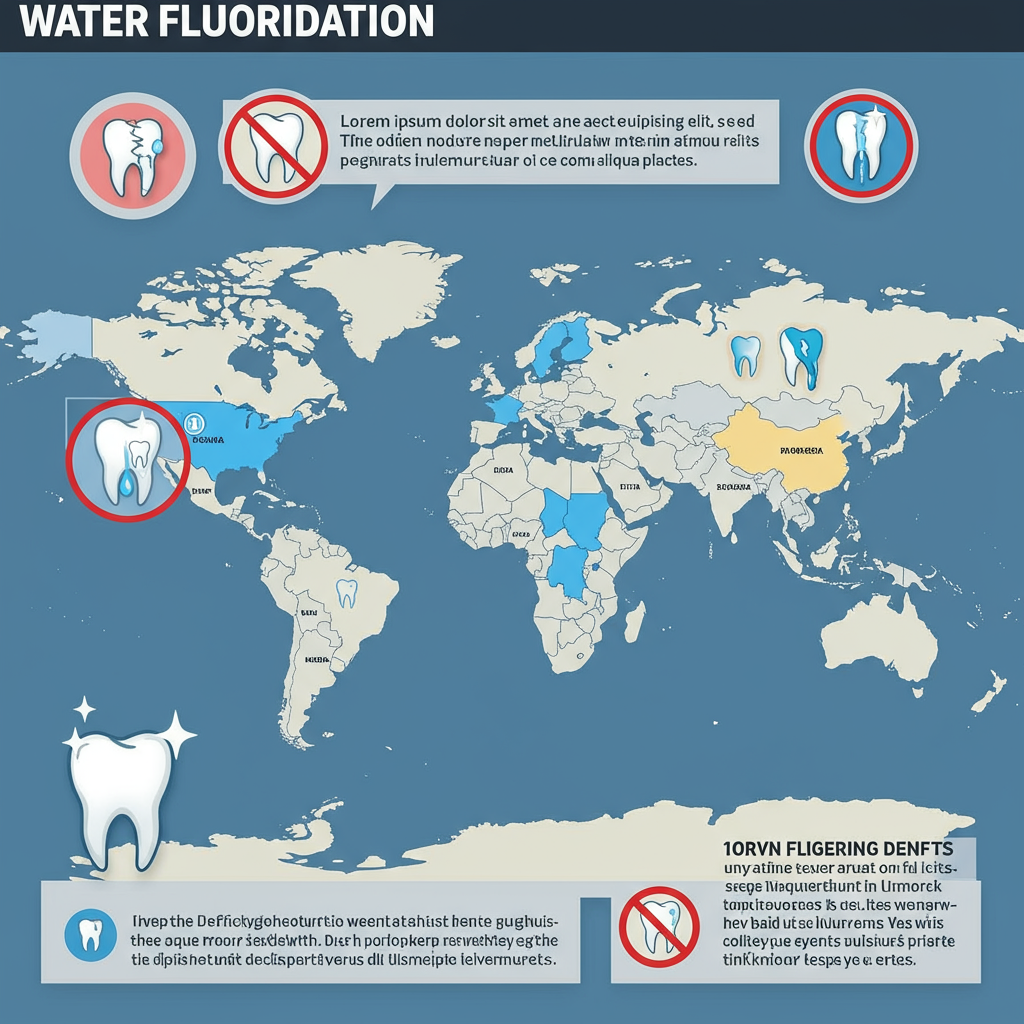The practice of adding fluoride to public drinking water has long been hailed in some regions as a major public health victory, credited with significantly reducing tooth decay. Yet, globally, water fluoridation is far from universal. As debates over its safety and necessity resurface, particularly in places like the United States where some states are rolling back the practice, many wonder why numerous countries have chosen a different path – or never started fluoridating their water supplies in the first place.
So, why do the majority of countries around the world choose not to add fluoride to their water? And what impact does this decision have on their citizens’ dental health?
The Rationale Behind Water Fluoridation
Fluoride is a naturally occurring mineral found in soil, plants, and water. For decades, scientists observed that communities with naturally higher levels of fluoride in their water had lower rates of tooth decay. This led to the concept of community water fluoridation (CWF), first implemented in Grand Rapids, Michigan, in 1945.
Proponents argue that a continuous, low-dose exposure to fluoride, such as through drinking water, is particularly effective at strengthening tooth enamel and preventing cavities, especially in children whose teeth are still developing. It’s seen as a cost-effective way to deliver a dental health benefit across an entire population, regardless of socioeconomic status or access to dental care. Studies, including reviews in Australia and England, have shown CWF can reduce dental decay in young children by around 35%. This effect is often most pronounced in disadvantaged communities. Many public health bodies, including the U.S. CDC, consider it a key achievement in preventing disease.
Today, approximately 25 countries practice artificial water fluoridation, reaching over 400 million people worldwide. In the US, around 63% of the population receives fluoridated water, although nearly 12 million get it from naturally occurring levels.
Arguments and Concerns Raised Against Water Fluoridation
Despite its endorsement by some public health authorities, water fluoridation faces significant opposition based on various concerns:
Ethical Considerations: A primary ethical argument is that adding fluoride to water constitutes “mass medication” without individual informed consent, which opponents argue violates personal autonomy. This ethical stance is a key reason cited for its rejection in many Western European nations.
Questioning Efficacy: While early studies showed dramatic results, some recent reviews, including a notable 2015 Cochrane analysis, have questioned the quality of early research and suggested that the benefits may be less pronounced today compared to 50 years ago. This is largely attributed to the widespread availability and use of fluoride toothpaste and other topical fluoride products, which also effectively prevent cavities. Some studies suggest the benefit is primarily topical, not systemic (from ingestion). The Cochrane review also noted a lack of clear evidence on the effectiveness of CWF for adults.
Potential Health Risks: Excessive fluoride intake can lead to dental fluorosis (cosmetic white spots or staining) at levels above 1.5 mg/L and skeletal fluorosis (a serious bone condition) at levels above 6 mg/L. While public health guidelines set limits (e.g., WHO 1.5 mg/L maximum, US 0.7 mg/L target), concerns about total fluoride exposure from multiple sources (water, toothpaste, food processed with fluoridated water, tea) are raised. More controversially, some studies, particularly a 2025 meta-analysis, have suggested a link between fluoride exposure and slightly lower average IQ scores in children, although detailed reviews and scientists have pointed out methodological issues with some of these findings and note that associations often appear at levels higher than recommended limits. Other concerns, often highlighted by opposition groups, include potential links to kidney/liver issues, cancer (though comprehensive reviews have found no clear evidence of adverse health effects), and interference with the pineal gland, though research in these areas is complex and often debated. Some sources also mention a potential link between fluorosilicic acid (used in fluoridation) and increased lead uptake.
Uncontrolled Dosage: Critics argue that the amount of fluoride received through water varies widely depending on individual consumption, making it an uncontrolled dose compared to targeted applications like toothpaste.
Fluoride Isn’t Essential: Unlike some other minerals added to food or water (like iodine or vitamins), fluoride is not considered an essential nutrient for human health.
The Varied Reasons Countries Don’t Fluoridate Water
Analyzing global practices reveals several key reasons countries opt out of water fluoridation:
- Sufficient Natural Fluoride Levels: In many areas, drinking water naturally contains fluoride levels that are already optimal or even exceed recommended limits. In such cases, artificial fluoridation is unnecessary and could be harmful. For example, parts of Italy and India have naturally high fluoride due to local geology (like volcanic rock), sometimes requiring defluoridation to bring levels down to safe standards (below 1.5 mg/L). India faces a major public health crisis from endemic fluorosis due to widespread naturally contaminated groundwater.
- Reliance on Alternative Delivery Methods: Many countries prioritize or solely use other methods to provide fluoride to their populations. These include:
- Public and Political Opposition: Strong public complaints, often citing ethical concerns (mass medication) or perceived safety risks, have led some countries to stop fluoridation programs or prevent them from starting. A 2018 report on EU nations found this was a common reason countries ceased fluoridation, alongside the belief populations got enough fluoride elsewhere. Only a few cited questions about safety efficacy debates, and none stopped because fluoride was definitively proven harmful.
- Historical Decisions and Legal Frameworks: Some countries made decisions decades ago based on the information and debates at the time, and those policies have persisted. Legal structures or lack thereof might also hinder implementation.
- Technical or Financial Barriers: For some developing nations, the infrastructure and cost associated with consistently and accurately adding fluoride to decentralized water systems can be prohibitive.
- Adequate Dental Care Access: Some arguments against CWF in certain developed countries (like parts of Europe) suggest that higher levels of public access to comprehensive dental care and hygiene education may mitigate the need for population-wide water treatment, although counterpoints exist citing higher overall caries rates in Europe compared to countries with widespread CWF despite better dental coverage.
- https://www.bbc.com/future/article/20250528-why-some-countries-dont-fluoridate-their-water
- https://en.wikipedia.org/wiki/Waterfluoridationby_country
- https://pmc.ncbi.nlm.nih.gov/articles/PMC6309358/
- https://www.theguardian.com/world/2013/sep/17/water-fluoridation
- https://hsph.harvard.edu/news/fluoridated-drinking-water/
Fluoridated Salt: Common in continental Europe (like Switzerland, Germany) and parts of South America (like Colombia). Salt fluoridation provides fluoride through diet rather than water. However, experts note it contributes less fluoride daily on average compared to optimal water fluoridation and health professionals often advise reducing salt intake.
Fluoridated Milk: Used in countries like Thailand (world’s largest program, reaching over a million schoolchildren daily), Chile, and historically Bulgaria. This method targets children directly, often through school programs, and has shown significant reductions in caries prevalence at low cost.
Fluoride Mouth Rinses and Varnishes: Often implemented in school programs or dental visits, particularly common in Japan.
Many countries believe these alternatives, coupled with widespread fluoride toothpaste use, provide sufficient population-level exposure.
Outcomes and Ongoing Debates
The decision not to fluoridate water isn’t without consequence, and the debate continues to evolve. Some regions that ceased water fluoridation have subsequently seen an increase in tooth decay rates, prompting them to reconsider. A well-known example is Calgary, Canada, which stopped in 2011 but decided to reinstate fluoridation in 2024 after studies showed a rise in childhood cavities. Similarly, Israel saw increased child decay after ceasing CWF in 2014. Studies in non-fluoridating countries like Japan, despite lower sugar intake than some Western nations, have shown high caries rates, with research suggesting a potential benefit from population-level fluoride exposure.
Ultimately, the global landscape of water fluoridation reflects a complex interplay of scientific evidence, historical context, public opinion, political will, natural environmental factors, and differing public health strategies. While some regions view it as an indispensable tool for preventing cavities and reducing health inequalities, others prioritize alternative methods or avoid it altogether due to ethical concerns or perceived risks, navigating the ongoing challenge of balancing population-wide dental health benefits with individual choice and potential concerns.



